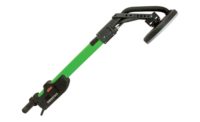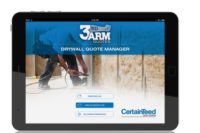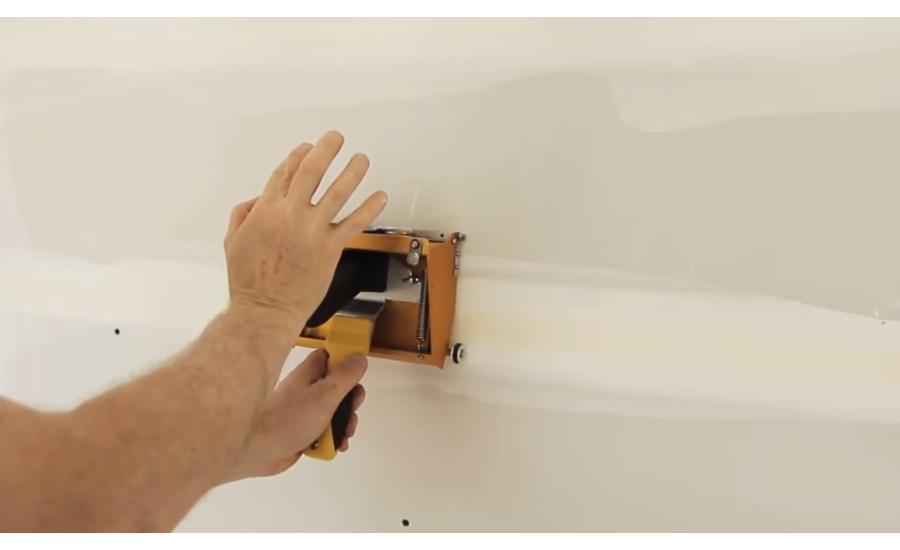Ask any drywall finishing contractor: finishing joints can be extremely time consuming and meticulous work, even for the most experienced industry veterans. Getting that even, consistent and clean coat takes patience, coordination and a steady hand. These developed skills can be put to the test when using a conventional drywall finishing box with a long handle that makes close-in work a challenge.
By giving the contractor the ability to mud and scrape a joint in one single motion, traditional drywall finishing boxes save time and effort, but these efficiencies don’t always translate in tight spaces. Jeff Oas, a self-employed drywall finishing contractor, feels that long handles can become awkward in some applications.
“Conventional boxes with extension handles create major challenges in tight spaces, such as closets, where there is insufficient room to maneuver them,” explains Oas, a Menomonie, Wisconsin interior finishing contractor. “They basically render a finishing box unusable in small areas.”
Scott Boldt, another self-employed finishing contractor, adds that simply learning to properly control the long handles can be a productivity killer. Boldt, who operates out of Waterloo, Iowa, explains, “you have to get the box at the perfect angle before engaging the handle’s break,” a skill he says that takes time to master.
Both men are now singing a different tune, however, after trying out a new finishing box with a self-contained, multi-grip handle. The model 8000 Wizard box handle from AMES Taping Tools eliminates all the problems typically associated with traditional long handles, while significantly improving productivity.
Nothing Like It
“I haven’t seen anything else like it on the market,” claims Oas, who explains that unlike traditional, longer handles, the Wizard box handle allows contractors to apply direct pressure to the box itself. The compact handle, 40 percent shorter than similar products, allows for greater maneuverability in tight spaces and control by staying directly in front of the contractor.
Greater control means greater consistency in applying mud, leading to a more even finish. Direct hand pressure releases the mud onto the wall, rendering a brake unnecessary. Indeed, by eliminating standard brake handles, the AMES Wizard handle eliminates the learning curve associated with them, allowing new users to be as fully productive as seasoned pros.
The Wizard’s flexibility and simplicity makes previously unheard of productivity times fully attainable for both experienced contractors and those new to the field.
A Seasoned Pro’s Perspective
Contractor Oas has been in the drywall finishing business for 27 years. In that time, he has finished thousands upon thousands of board feet, using both 12-inch knives and boxes. After testing the Wizard box handle, Oas instantly recognized its time-and effort-saving attributes.
Oas extols the short handle’s ability to aid drywall finishing in the tightest of spaces. “I was able to finish quickly and consistently in closets and short runs with the Wizard handle, something I couldn’t have done before.” He explains how on one particular job, applying mud in a 3x6-inch closet was no problem because he could place his hand directly over the pressure plate.
This ability also made him feel safer on high runs. “It’s tricky to use a traditional box handle while finishing a high wall on scaffolding because you’re pushing more weight away from your body and increasing the chance of accidental fall,” explains Oas. He maintains that the short Wizard handle mitigates that chance, instilling a greater feeling of safety for him and his fellow finishers.
Chief among Oas’s praises for the Wizard handle involved its ability to evenly and quickly finish butt joints. “Butt joints are typically the most difficult to perfect, and traditional handles made it too hard to effectively control the box and get the job done” recalls Oas. “With the Wizard, I had far greater control and maneuverability.”
Overall, Oas estimates that he trimmed 30 percent off his time using the Wizard box handle on butt joints and halved his time on high work and closets. “It really streamlined my speed and productivity.” He attributes much of the saved time to the handle’s simplicity. “It’s so simple that someone who has never used a box handle before would catch onto this more quickly than someone who has.”
A New Finisher’s Perspective
Contractor Boldt echoes Oas’s praise for the innovative new tool. Relatively new to the drywall finishing business, which is a second job for him, Boldt has worked mostly with taping knives—never a box handle. Therefore, using the Wizard box was a completely foreign concept, but he was not disappointed.
“It saved so much time,” he emphasizes. “With a traditional knife, you’re constantly taking it in and out of the pan to ensure you have the right amount of mud; with the Wizard, you can apply a consistent layer with one fluid motion. I have even used it with one hand.”
Like Oas, Boldt found the Wizard especially useful in handling tight closets and wall butt joints, which are often awkward to evenly coat with a traditional handle. “The handle makes the small areas quicker and easier to finish. The control you have with the Wizard, especially on the outside corners, lets you run right down the edge. You can pull out of one corner, turn the handle over, and immediately pull out of the other,” he explains. “It will save you time and effort on any joint you can reach with your hand.”
Boldt maintains there was absolutely no learning curve with the Wizard handle. “I had used a finishing box with the longer handle once before, and it definitely took time to learn to use those brakes,” recalls Boldt. “Anybody can use the Wizard box handle the first time, no problem. Essentially, it allows the box to become a natural extension of my own arm.”
Simply Irresistible
Since testing out the Wizard handle, both men plan on purchasing it for their business. “I already have one on order,” says contractor Oas. “I don’t even know how much it costs, but it doesn’t matter to me,” he freely admits. Both contractors also intend to recommend the time-saving tool to other drywall finishing contractors. “Anybody who does drywall would be a fool not to own one,” declares Oas.










